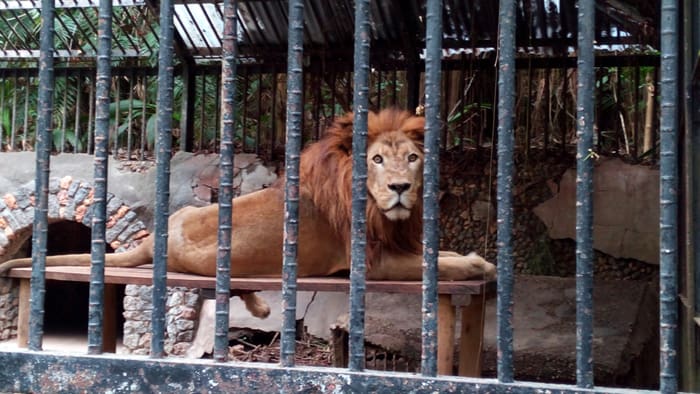Three of my colleagues told me they’d never been to the Simón Bolivar Zoo — which is three blocks from The Tico Times office in San José — because they’d heard it’s too depressing to see all the animals stuck in their sad little cages.
But I braced myself, walked over to the zoo, paid the ₡2,600 admission and went in to see for myself. My visit turned out to be both emotional and educational — it was sad, but there was a backstory behind this sadness that I didn’t know.
Zoos nowadays tend to have a bad reputation, thought of as places where formerly happy wild animals are caged so that people will pay money to gawk at them. “Animal rescue centers,” on the other hand, generally enjoy a positive reputation — they are nurturing damaged animals back to health in hopes of releasing them (though still charging money for tourists to see the poor animals).
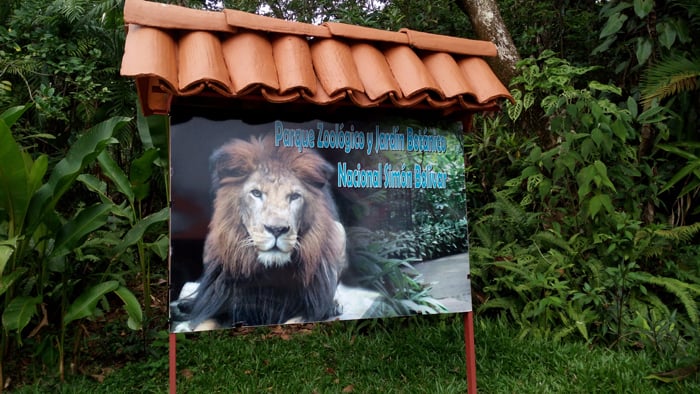
What I didn’t know is that virtually all the animals at the nonprofit Simón Bolivar Zoo are also damaged in some way — orphaned, injured or disabled— and that they are also nursed back to health here in hopes of releasing them. So what, exactly, is the difference?
‘Gloomy’ conditions
As I entered the zoo down a leafy path, the spider and white-faced monkeys glanced at me briefly but looked lackadaisical and sad. Their enclosures were not as small as I feared, but let’s face it, these creatures are imprisoned, and no matter how large the cell, there’s no escape.
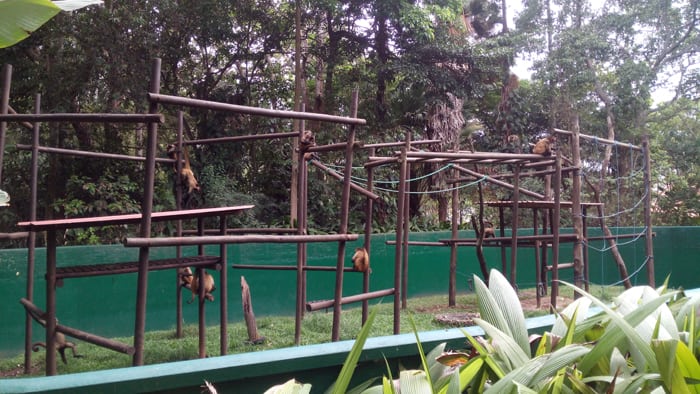
The coatis, which are so frisky in the wild, were just lying around on their platforms. But it was starting to rain, I reasoned, and an afternoon rain is not a bad excuse for any species to lie down under a roof for a nap.
The lion, whose name is Kivu and who was born in a zoo in Cuba, lay sleeping on a wooden table with his back to the family trying to get his attention. I did think his enclosure was really small, and it was easy to imagine that this “king of the jungle” had a lonely and depressing life, with nothing to do and nowhere to go. He used to have a lioness for company, but she died.
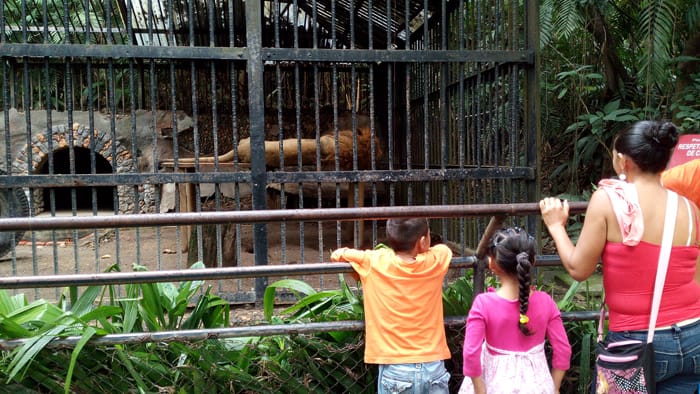
Jimmy Vega Jiménez, 31, was visiting the zoo with his family and thought it had deteriorated a lot since he came here as a child.
“They’re very skinny,” he said. “The monkeys, the lion, the parrots, they look very thin to me.” He described the animals as looking bored and poorly cared for.
“It makes me sad, to tell the truth, when I see the animals,” he said. “It’s nice to see them, but I want to see them well fed, and here they seem all gloomy and sad. It doesn’t bring you a lot of joy.”
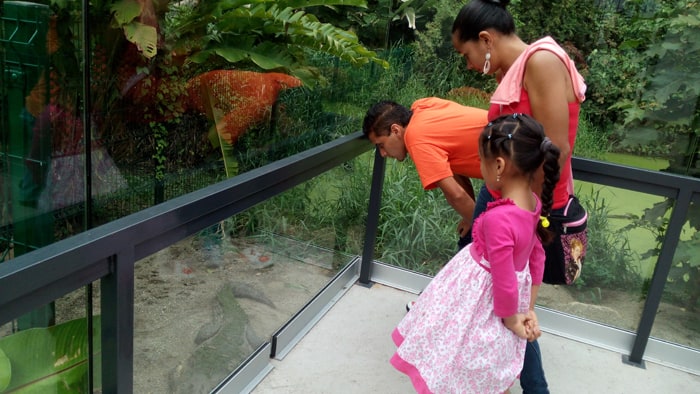
So yes, it was depressing to see all these animals stuck in their sad cages. And yes, in theory I would agree with those who say that zoos should be closed, that wild animals should not be caged for human amusement.
The zoo’s story
But it’s not quite that simple, and there’s another side to the story. I talked to Eduardo Bolaños, who manages public relations for the zoo (formally the Parque Zoológico y Jardin Botánico Nacional Simón Bolivar — oddly named after a liberator). The main Costa Rica zoo, it was established in 1916 and is celebrating its 100th anniversary this year.
“The animals here were rescued,” he said. “They were never taken out of nature by us. They’re all rescue animals, except the lion, which was born in a zoo. All are rescued — mammals, birds, everything. They were picked up as (orphaned) juveniles, or they had gunshot wounds or blows or other injuries.”
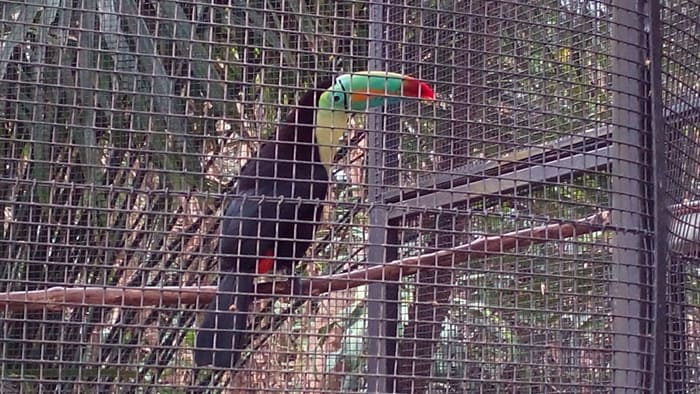
He said the zoo takes the animals in, gives them medical attention, gives them the milk or food they need and gives them a place to live where they will typically outlive their life expectancy in the wild.
“We have a rescue function — that’s our principal function,” he said.
He said the primary goal is to return the animals to the wild, but in many cases that would be a death sentence for them, so the zoo gives them the best life it can.
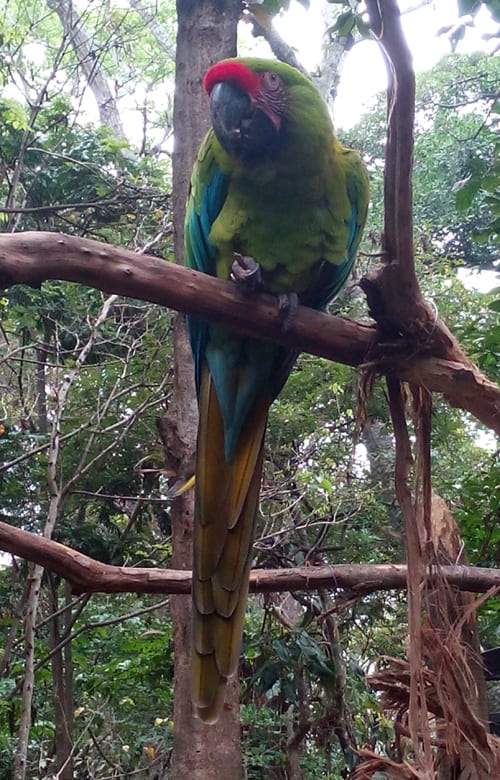
“More than 70 percent of the animals that come to the park are returned to nature,” he said. “That’s very important because people think the animals here were captured by us, but that’s not right.”
I found this 70 percent figure hard to believe, but he insisted it was true. The zoo has 60 species and about 350 individuals, counting mammals, birds, reptiles, fish and amphibians. He said animals are brought here by animal welfare authorities, police, firefighters and the Red Cross.
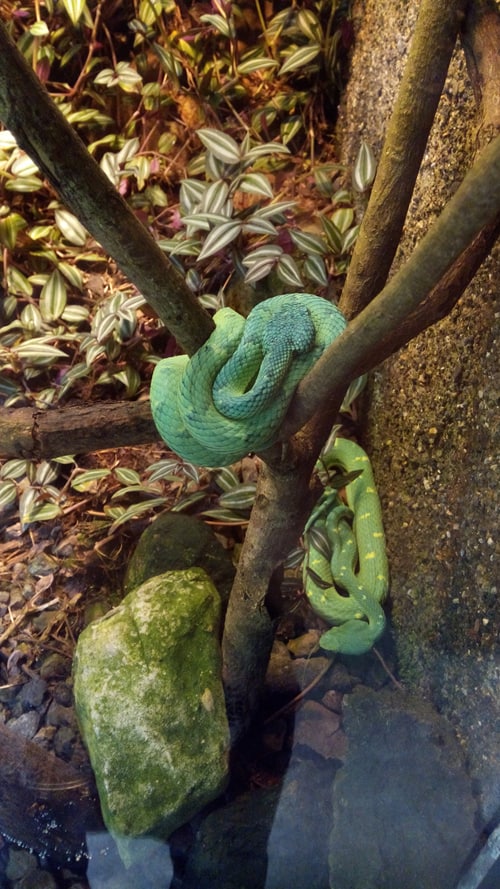
“Snakes, most are returned to their habitat,” he said. “Snakes and birds are brought to the park a lot, and the majority are returned to nature. The ones that are here need special care, and it’s better to keep them here so that they survive.”
He recalled a recent case in which a hawk tried to catch a chicken on a farm and somehow broke its wing.
“They did an operation where they take part of the bone, part of the sternum, and they rebuilt his bones with plates, and he acquired movement in his wing again,” Bolaños said. “But it’s not enough for him to return to nature. He would die of hunger.
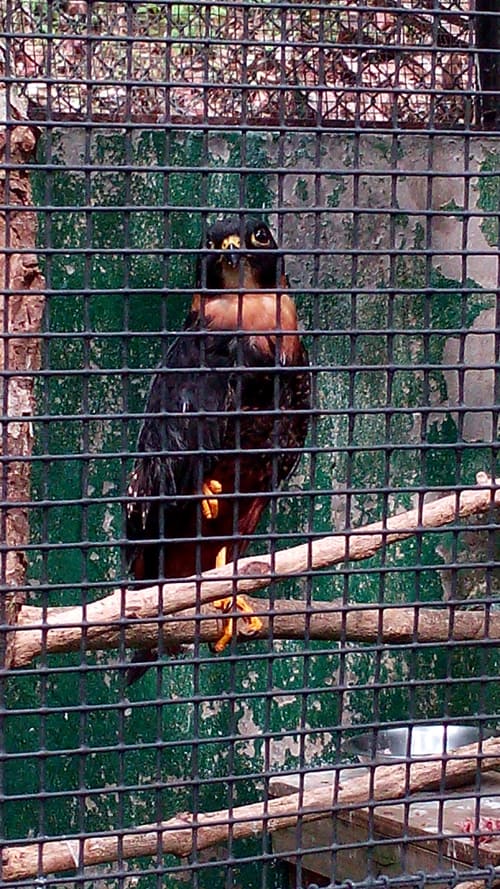
“That’s what would happen to the animals of the zoo: They would die of hunger. So we keep them here, and we give them the best quality of life possible.”
I asked about the story of the gorgeous jaguar, whose name is Brutus.
“I think he came from the Osa,” Bolaños said. “They rescued him as a cub; someone killed the mom and he never got mother’s milk. So he developed a problem that left him with short legs. Normal jaguars have taller legs; he’s much shorter. So here we had to feed him and bring special milk from the United States so that he could be hand-fed and could survive.”
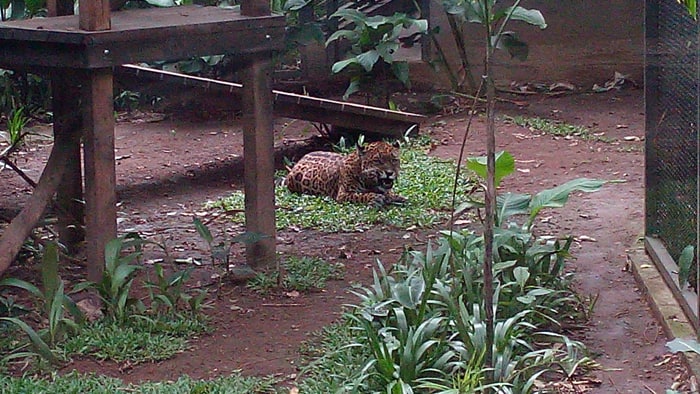
This zoo was looking less evil all the time. But I pressed Bolaños on what he thinks of people who say that zoos shouldn’t exist, that animals shouldn’t be put in cages for people to gawk at.
“The people who say that animals shouldn’t be in captivity, like in a zoo,” he said, “don’t know that a zoo is in reality like a hospital for animals.”
Attempted shutdown
In 2013, Costa Rica’s Environment Ministry (MINAE) declared that Costa Rica’s two zoos (this one and the Conservation Center of Santa Ana) would be closed, with animals relocated to rescue centers or cage-free environments. Fundazoo, the nonprofit organization that manages both zoos, fought back in court, citing a clause in its contract that automatically renews it for 10 years unless the proper paperwork is filed a year in advance.
That same year, three arrests were made when animal rights activists staged a protest at the zoo. Organizer Edgar Samper, head of Animal and Earth Resistance Front, said, “We marched against the exploitation of all animals. Simón Bolivar Zoo is the largest institution of animal exploitation that we have in this country.”
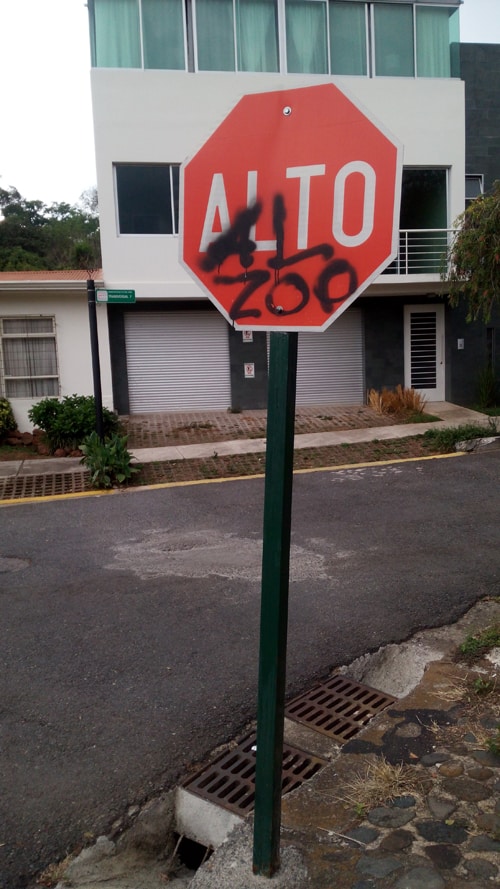
Yet in 2014, a court agreed with Fundazoo, saying MINAE’s notification that it would not renew Fundazoo’s contract was delivered a day late. The zoo closure was effectively halted and the contract renewed until 2024 (despite rumors that circulated on social media in 2015, recycling old news saying Costa Rica was closing its zoos.)
I talked to Luis Diego Marín, regional coordinator of the environmentalist group Preserve Planet, who said conditions at the zoo are completely inadequate for the well-being of the animals there.
“The cages, the way it’s structured as a zoo from the last century, or the century before that — the animals are in cages where they have visual contact with people,” he said. “It’s been around for 100 years, and they’ve made improvements, but they’re mostly decorative. The cages are too small.”
He said if the zoo was serious about animal rescue, it could stop promoting itself as a zoo and close its doors to the public.
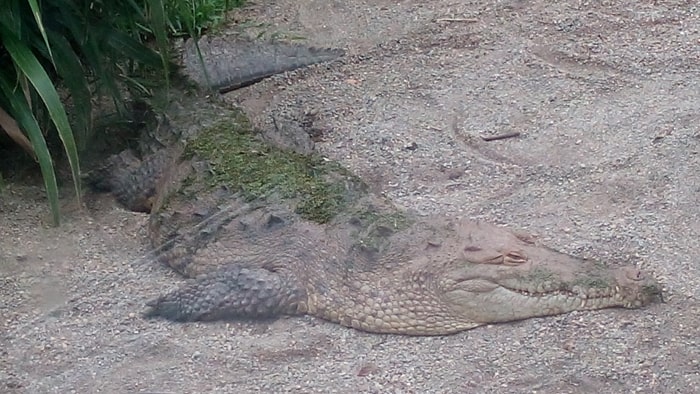
“That place is not an example for tourists to visit, much less children, because the conditions are not appropriate,” Marín said. “If it’s a place for animal rescue, the public doesn’t have to see them.”
He cited the Zoo Ave animal rescue center in La Garita as a model to be emulated, saying conditions are much better and enclosures much larger there.
But Zoo Ave is also open to the public and charges $20 admission, four times as much as Bolívar. I asked Marín how the latter would pay for the care and feeding of animals if it closed to the public, and he said the financing issue has to be resolved by the government.
“There’s a budget that should be used for that,” he said, “not to use the animals as a pretext to keep a place with inadequate conditions open.”
Bolaños said the zoo is constantly improving and enlarging the habitats of its wards. Construction workers were out the day I visited working on new aviaries for birds that are currently being kept in the clinic.
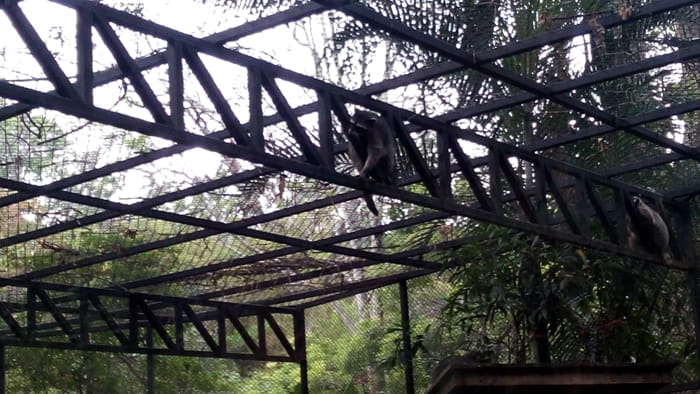
“We’re remodeling almost the entire park,” he said. “Right now, they’re making four aviaries, and they just finished the habitat for the sloth. … A while ago we finished the jaguar and raccoon habitats, and the kinkajou and gray fox enclosures were done last year.”
I thought the animal most in need of a new habitat was the lion, given the cramped quarters it had now. Bolaños said the lion will get a hew habitat too, after workers are done building the aviaries, building a trail to a botanical museum and remodeling a picnic area with games for children.
These priorities struck me as backwards, but what do I know? I’d been here less than two hours, and the zoo has been here 100 years.
Major changes looming
I spoke at length with Shirley Ramírez, 40, wildlife adviser in the office of the vice minister of the environment at MINAE, who said the management of animals in captivity in Costa Rica has historically been a “disaster,” with very little effective regulation.
She said many “animal rescue centers” in fact function as zoos, putting their animals on public display for a fee.
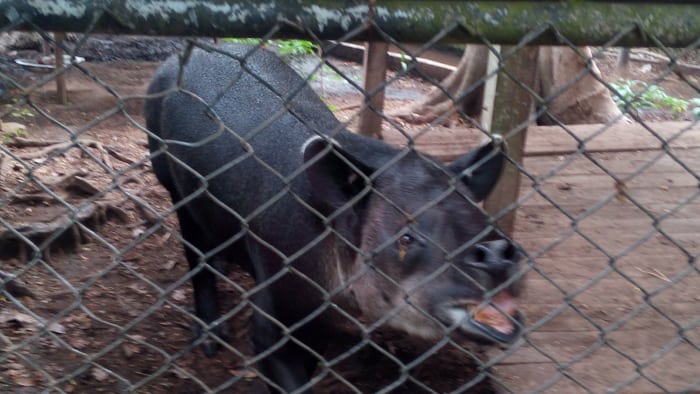
In 2013, Costa Rica passed a sweeping Wildlife Conservation Law that defined the difference between the two:
- Zoos, which can be nonprofit or for-profit, are allowed to publicly display animals that cannot be released, and to conduct environmental education programs.
- Animal rescue centers, which must be nonprofit, exist to rehabilitate and release animals, and must be closed to the public.
Specifically, the law defines “zoo” as follows (emphasis added):
“Zoo: Management site where wildlife is kept in captivity, whether or not for commercial purposes, under the direction of a corps of professionals that ensures adequate living conditions in an attractive and didactic manner for the public. Its main objectives are the scientific conservation, education, research and display of wild fauna.”
And the law defines “rescue center” as follows (emphasis added):
“Rescue Center: Wildlife management site which aims to rehabilitate wildlife that has been rescued, seized or surrendered voluntarily for the purpose of their recovery and reintegration into their natural environment whenever possible. Wildlife organisms whose conditions do not permit their return to the wild will be deposited at wildlife management sites defined herein. The sites are non-profit and closed to the public.”
“The most important thing,” said Ramírez, who helped write the law, “is that these sites are nonprofit and they’re not open to the public.”
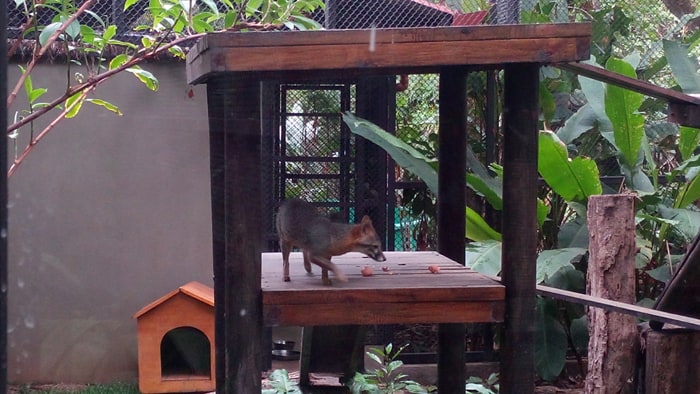
I pointed out that multiple animal rescue centers in Costa Rica are open to the public, and Ramírez agreed but said they are not in compliance with the new law.
“The first process that’s going to happen is that these sites have to change their category,” she said — meaning most rescue centers will have to become zoos.
I asked why rescue centers have to be closed to the public. Is it because human contact causes too much stress to animals that could be released?
“It causes stress, and the primary predator of wild animals is man,” Ramírez said. “A wild animal that isn’t afraid of people is an animal that can’t be freed.”
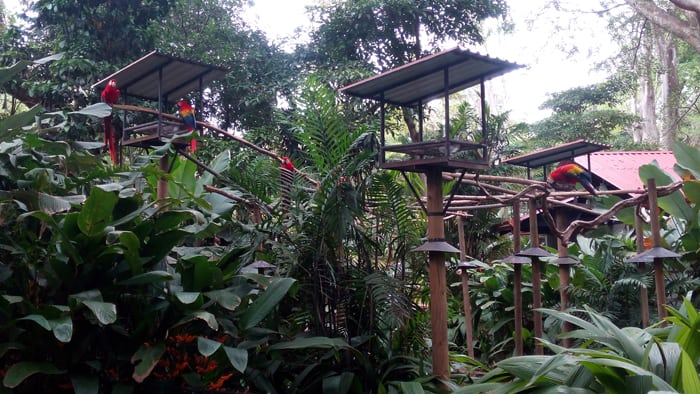
The reason rescue centers continue to operate as they always did, she said, is that regulations have yet to be adopted to enact the law, but she expects that to happen by the end of this year.
She said the new law represents a “paradigm change,” but I’d say that for the average animal rescue center, that may be an understatement. It sounds to me like a tsunami that will wash away the operating models of most rescue centers in Costa Rica.
If they want to continue to exhibit animals to the public, bringing in critical funds, they will need to apply for a permit to operate as a “zoo” — a word widely hated at these places.
If they want to remain rescue centers, yet continue to publicly exhibit animals, then they will need to apply for two separate permits with two separate management plans, Ramírez said. And they will need to build separate enclosures for non-releasable animals shown to the public (the “zoo”) and potentially releasable animals hidden from the public (the “rescue center”).
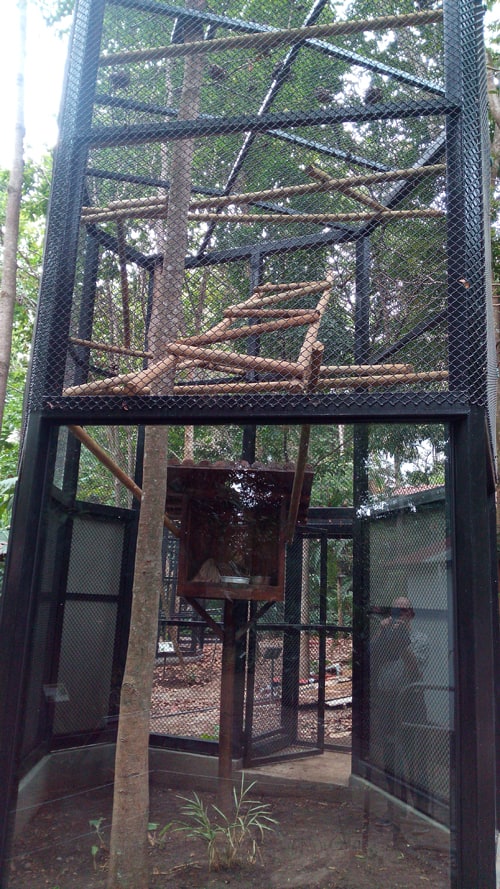
Ramírez said casual human contact with animals, which is common at some rescue centers, is also prohibited. While veterinarians and other staff members can interact with the animals as needed, visitors and even volunteers should not be petting, touching or playing with animals.
At some rescue centers, I know from experience, interaction with the animals is one of the primary attractions, whether it’s scratching a monkey or feeding a sloth. So now monkeys that used to roam freely among visitors will have to spend the rest of their lives behind bars?
I had come to MINAE to talk about a troublesome zoo, but as the new law was explained to me, the zoo was starting to look like a model citizen: It was actually allowed to exhibit animals, and it certainly didn’t allow visitors to touch them.
But most animal rescue centers, it appeared, were doing everything wrong. Never mind if they let visitors touch the animals — they’re not supposed to allow visitors!
My main question, before I learned all this, was what would happen to all the animals at the Bolivar Zoo if it were closed.
“Wild animals are a trust of the public domain,” Ramírez said. “The state, by means of MINAE and SINAC, would be responsible for making those determinations. Every animal would have to be evaluated separately.”
And who would pay for the relocation and the perpetual care and feeding of all these animals?
“There are some institutions, national and international organizations, that have said they could support us in this process, primarily national organizations, to take in the animals and maintain them for life,” Ramírez said. She mentioned the National University (UNA), the University of Costa Rica (UCR), the National Animal Health Service (SENASA), the Association of Biologists and the Association of Veterinary Doctors.
“They are prepared to collaborate the moment a decision is made from a legal standpoint and we proceed with the closure of that site,” she said.
Yet I found it doubtful that the money needed to care for these animals for life would easily materialize. And as for where to send them, the logical idea would be animal rescue centers, but they appear to face far more legal problems under the new law than the zoo.
Post-nap stir
Toward the end of my visit to the zoo, many of the animals became more active as the rain let up. Kivu the lion awoke from his nap and paced his cell, occasionally vocalizing loudly in what didn’t sound like a typical lion roar but a haunting “Ooooooo!”
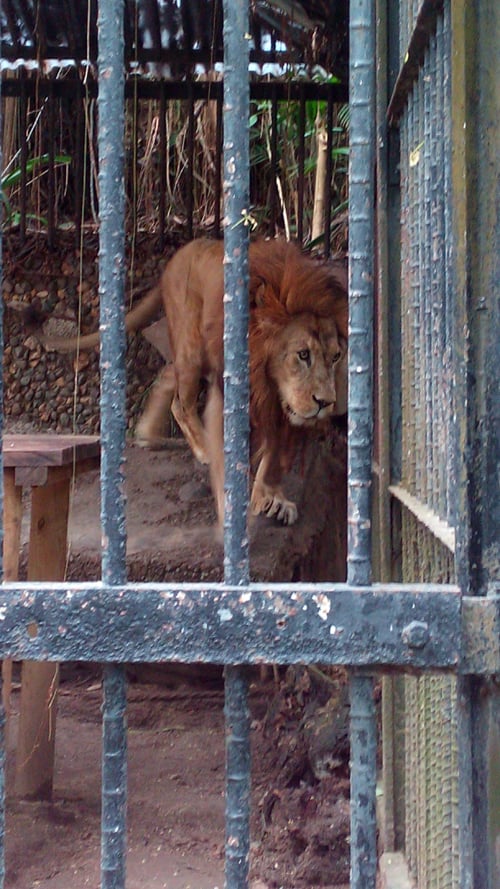
Brutus the short-legged jaguar came out of hiding and lay down on the ground, licking a paw.
A beautiful tapir jumped out of its bath and started jogging around the inside of the fence, like a convict getting his daily exercise in the yard.
The gray fox was hopping around in its space, and the raccoons were climbing in theirs. The coatis and monkeys, too, woke up from their slumber, and the badger was running around the walls of its enclosure.
The two-toed sloth, predictably, slumbered on.
I was struck by the fact that I had seen almost all these animals in the wild in this country, many of them multiple times. If there’s one country that doesn’t need zoos to entertain humans, I thought, it’s Costa Rica.
But what if entertaining humans is not the main purpose, but to doctor, nurse, feed and house damaged animals that would die in the wild? What if the zoo is not there for the humans, but for the animals?
I know there are plenty of activists who would say we aren’t doing the animals any favors. Like them, I would prefer that this zoo did not exist.
But it’s a little late for that, and easy solutions are few.
IF YOU GO
Getting there: Simón Bolivar Zoo (Jardín Zoológico Simón Bolivar) is located in Barrio Amón in north San José, 300m north of Parque Morazán and 200m east.
Hours: During the rainy season, Mon.-Fri. 8 a.m.-3:30 p.m.; Sat.-Sun. 9 a.m.-4:30. Hours slightly different during the dry season.
Admission: Children under 3 free; children 3-12 ₡1,900; adults ₡2,600; seniors 65+ ₡1,900; same price for foreigners and nationals.
For more info: http://fundazoo.org/web
Contact Karl Kahler at kkahler@ticotimes.net.

